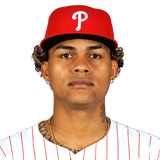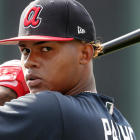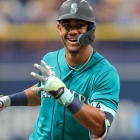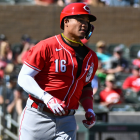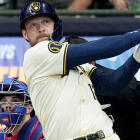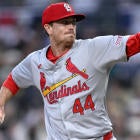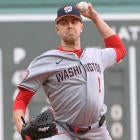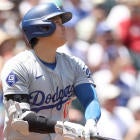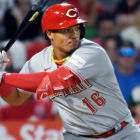Determining which prospects will turn into successes at the MLB and which will fail is ... well, it's more art than science. And for most of us, it would amount to little more than guesswork if not for the blessing of consensus, which seems to be the most reliable measure we've got.
Still, even that's not foolproof — as anyone who invested in Byron Buxton or Dylan Bundy (not to mention Jesus Montero or Taijuan Walker) would tell you — so it helps to have additional criteria. You can evaluate a prospect on a number of levels, of course, but the easiest for the layman is the stat line.
So that's where we begin today's mailbag, pulled from members of our Fantasy Baseball Today Facebook group:
Which stats for both hitters and pitchers do you find most indicative of future success? - Alex Prado
It's the same for both: plate discipline. Primarily, I mean strikeouts — as in frequency, not raw total — but walks follow closely behind. The simplest explanation for it is probably one you've heard in other contexts: Those stats are defense-independent, which is especially useful given that defense in the minors is ... not great, Bob.
And I actually think strikeouts and walks reveal more for hitters than for pitchers, who often sacrifice performance for the sake of development. They'll have whole seasons where they're working on a new pitch and, thus, throw it more often than optimal. Maybe it's pitch selection in general that's holding their numbers back. We don't always know what's happening behind the scenes, and so the numbers can often mislead us. Still, in those instances when a starting pitcher comes up and blows away expectations, you can usually look back at the minor-league strikeout and walk rates and see why.
For hitters, a high strikeout rate is the biggest cause for concern. It's less about the upside than the floor. If they're already having trouble making contact against scrubby minor-leaguers, then they may be overmatched against the best class of bat-missers the game has ever seen, which is what today's pitching crop is. Again, it doesn't always work that way: George Springer and Kris Bryant stand out as top hitting prospects whose strikeout rates scared me, and contact has turned out to be a strength for both. But the history of failed hitting prospects is littered with players that just couldn't put bat to ball enough.
The stat that means virtually nothing to me? Stolen bases. Most every player runs a lot more in the minors than they do in the majors. It's a lower-stakes environment that exists largely for showcasing skills, after all. Home runs tend not to be especially revealing either, at least for hitters, though they more often underestimate a player's power rather than overestimate it.
What are your thoughts on Christian Pache? -Slayton Vest
He's a fitting choice for the theme of today's column since he's a top prospect with underwhelming minor-league numbers, and yet the consensus is so great, with virtually every rank list putting him in the top 25 (and some having him on the verge of the top 10) that I'm not comfortable going against it.
No doubt, the defense has something to do with it. He rates as plus-plus in center field and will almost certainly be a useful major-league for that reason alone. But if that's all he brought to the table, he'd be more like an honorable mention on all of these top 100 lists. Kevin Kiermaier was never a top-100 prospect, after all.
| ||||||||||
No, Pache ranks alongside prospects with franchise-reshaping potential — which isn't to say he's certain to meet that potential, but heck, none of them are. For him, there remains a belief he still hasn't peaked offensively, and when you look at the strides he has made in terms of strike-zone judgment and ability to drive the ball over the just the past two years — he went from having no home runs with a .343 slugging percentage in 2017 to 12 home runs with a .462 slugging percentage last year — it's easy to see why.
Of course, it's possible his defense propels him to the majors before his bat is quite ready, which wouldn't be the best thing for his development. And with me being the risk-averse sort, he's only 24th in my top 100. But I'm not so arrogant to predict Pache will be a bust — not at this stage of his development.
Do you generally draft pitching prospects over hitting prospects, or vice versa? -Sean Millerick
As loudly as I've declared myself to be Team Pitching for 2020, proven-ness is the determining factor there. Breakthroughs have become rarer and more difficult to predict at starting pitcher, for a variety of reasons, making it the last place I'd want to put my faith in hypotheticals.
Prospects are by definition hypotheticals, and if hypothetical hitters are paying off more regularly then hypothetical pitchers, well, it stands to reason I would want more of my hypothetical players to be hitters.
There's also the old acronym TINSTAAPP (i.e., "there is no such thing as a pitching prospect"), which refers more to how often injuries invalidate pitching prospects, and it's certainly still in play. I feel like some take it so literally that they never draft pitching prospects, which is probably the wrong way to do it. But the high attrition rate means there are so many pitcher prospects that you shouldn't worry so much about the pool being depleted
Once especially high-end types like MacKenzie Gore, Casey Mize, Nate Pearson, etc. are off the board, just wait for the bargains at starting pitcher.
Do you suspect Jasson Dominguez will make his MLB debut before age 20? -Steve Schneider
It's a difficult prediction to make for a 17-year-old who hasn't played his first professional game yet, but I can't recall a prospect who seemed better equipped to do it. Some scouts have called Dominguez the best international prospect they've ever seen, and according to Baseball America, the switch-hitter has recorded exit velocities of 108 mph from both sides of the plate in batting practice, which would already be enough to play in the majors.
He has a patient approach, good strike-zone judgment, blazing speed and a plus defensive profile. On the scouting reports alone, a Mike Trout comp seems appropriate, but of course, scouting reports don't tell the whole story.
Remember Kevin Maitan? He was getting Miguel Cabrera comps when the Braves signed him for $4.25 million out of Venezuela. Now he's a pudgy 20-year-old who can't even crack the Angels' top 30 after hitting .214 in low Class A.
The further out you try to predict an outcome, the less reliable that prediction is going to be. These players are signing as teenagers. They still have so much growing to do — physically, mentally and emotionally — before you even get to the refining of their baseball skills. These evaluations are being made in the dark, practically speaking, so it should come as no surprise that the miss rate is high.
Even if everything goes according to plan for Dominguez — and again, I think he's about as projectable as a 17-year-old can be — he'll more likely be 20 or 21 before we see him in the majors, but 19 is possible.
Do you think a prospect's highest value is typically right before he reaches the majors? -Connor Peterson
Typically, yes. It's difficult to say which prospects will go on to meet the full extent of their potential, and the ones who do, emerging as early-round picks in Fantasy for years to come, of course do see their value improve after reaching the majors. It also depends how loosely you want to define "prospect." The less-hyped ones might not even be on anyone's radar until they begin producing in the majors.
But generally speaking, a prospect's value goes down once he reaches the majors because most don't meet the full extent of their potential. And once that best-case scenario is off the table, he loses the benefit of imagination.
It's true in real life, too, but with one crucial difference: Prospects are essentially free for their first three years in the majors and generally discounted for three years after that. They'll miss more often than not, sure, but when they hit, the benefit is twofold.
So unless your dynasty league has a similar pricing mechanism, you shouldn't value prospects quite like your favorite team does. Many dynasty players make that mistake and then are left high and dry.
What do you think of Luis Patino? All this talk of MacKenzie Gore and Chris Paddack, but I like his arsenal. -Michael Blackfield
Oh yeah, Patino is a big deal. He tends to get overshadowed because Gore is the biggest of deals among pitching prospects and Paddack was already a rousing success last year, but I'd take the Padres' young trio over the Tigers' young trio of Casey Mize, Matt Manning and Tarik Skubal.
Sure, it's mostly because of Gore and Paddack. But the fact they're not as often cited as part of a trio tells me the Fantasy Baseball world is sleeping on Patino, who Baseball America ranks 18th, MLB.com ranks 27th and Baseball Prospectus ranks 15th. That's higher than Manning or Skubal, for crying out loud.
2019 stats
Patino: 6-8, 2.57 ERA, 1.13 WHIP, 94.2 IP, 38 BB, 123 K
What has allowed Patino to rocket up the rankings is continually improving velocity. His fastball now rates as 70-grade, peaking at 99 mph, and he's still just 20 years old. With a plus slider and curveball and decent command of both, he may be like Walker Buehler and not even need a changeup, but then again, he still has time to develop one. It's easy to forget how young he is given how far he has climbed up the ladder already.
Personally, I rank Patino 31st among prospects, behind both Mize and Manning, but I'm downgrading him some because he hasn't been tested as much at Double-A yet. He has all the upside of an ace, though.



